Deb Vanasse's Blog: Book Birthday!, page 12
December 10, 2013
Get Your Book Reviewed: Ethics and Etiquette
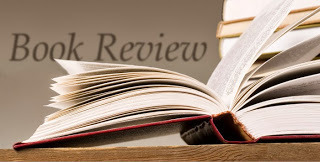
Whatever your opinion about the online giant Amazon, it’s hard to dispute this recent statement by founder Jeff Bezos:
“Amazon is not happening to book selling. The future is happening to book selling.”
As the future happens, discoverability and social proof are two words you hear a lot. These concepts have always been part of the book industry, but they’re evolving with the digital revolution, and that includes the good old-fashioned book review.
Reviews have been around pretty much since the first cave person drew on a rock and the next cave person pointed it out to his buddy. These days, discoverability and social proof in reviews is split between established industry insiders and regular readers in what amounts to a large-scale democratization of the process that raises a whole lot of interesting questions.
Last week, I mailed out the first round of review copies of my next new release, No Returns , to four traditional reviewers. The process took a lot longer than I expected, which is why I like hybrid projects where I can work with traditional publishers on print editions. I’m also trying Story Cartel to encourage more honest, genuine reviews of my first novel, A Distant Enemy , a digital reprint which has suffered from a case of stale-reviewitis.
This week, my pointers on ethics and etiquette for book reviews. Next week: where and how to get your book reviewed. Note that here I’m talking only about actual reviews, not author blurbs (sometimes called endorsements) or beta reader responses.DON'T buy phony reviews. Never. Ever. I don’t care how many you can purchase on Fiverr or who else is doing it. It’s slimy and wrong. Incentives for real, honest reviews? That’s a different story. Publishers do it all the time. They send free books to traditional reviewers. They invite reviewers to fancy parties they throw at conventions. They probably do other schmoozing that I don’t know about. That’s why I don’t feel bad about offering giveaways for reviewers who take the time to read my books and share their honest opinions with the world.DON'T ask (beg, plead with) strangers to review your work unless they’ve identified themselves as reviewers who are open to such queries. When you approached the proclaimed reviewers, do so in a sincere and professional manner, and pay close attention to the reviewer’s submission guidelines. The response might surprise you. My friend Don Rearden landed a review of his book (Penguin, 2013) in the Washington Post this way, and it’s now made the Post’s 50 Best Books of the Year list.DO keep your friends and fans appraised of your book news, and let them know that you welcome reviews. DON'T pester people. Never. Ever. Repetition is acceptable on social media (to a point—no more than four times is the rule I try to follow when I’m announcing something new), but that should be information, not pleading or demands for reviews. One follow-up to people who requested your book for review is my personal limit. We’re all busy, and we can’t always follow through on our good intentions. And believe it or not, there are some lovely people, maybe even members of your own family or your close friends, who simply don’t want to review your book, no matter how much they love you. (Not to mention that Amazon tries hard to filter out reviews by your nearest and dearest.)DO exchange reciprocal reviews (honest! genuine!) with your closest author friends. At first, I wasn’t sure this was good practice. When Amazon first came on the scene, a friend who writes for young readers asked if I’d post a review of her book on Amazon to help counter a bad review that appeared to have been written as a school assignment. I did the review, but it felt a little weird. Then I started getting school assignment reviews of my books, like this one written in 2000: “I usually read science-fiction books so I really don't know how to compare this book to others very well.” Now I understand that one of the best ways to help a writer’s book get discovered is to post an honest review, or even to write one for your local paper, as my one of my favorite authors Bill Streever did recently. (Bill’s an accomplished reviewer, by the way. See his post on how to write reviews for major publications.)DO thank reviewers when you have a personal relationship with them. You might even want to thank all reviewers, regardless of whether you know them. I have friends who do this, although I think it’s best done privately, if possible.DO make a practice of reviewing the books you enjoy on Goodreads and Amazon, whether you know the author or not. DO consider sending out no-strings-attached copies of your book to people you appreciate. I received a book this way from one of my favorite authors, David Vann, with a nice note saying he simply wanted me to have a copy. Of course, I reviewed it. For more on the book review process, see the helpful articles offered by the Midwest Book Review.
Published on December 10, 2013 08:00
December 4, 2013
Deb: Wild Dominion
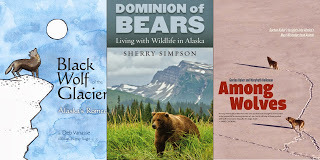
Years ago, I woke with a vivid image in my head: a large black wolf. I have no idea how that wolf got into my dreams. I didn’t even know at the time that wolves might be black.
Fast forward several years. I opened the newspaper to a photo of my dream-wolf, a black one named Romeo. He lived in Juneau, at Mendenhall Glacier, and he was famous not only in Alaskabut all over the world.
That wolf of my dreams inspired a book. Earlier this year, the University of Alaska Press released Black Wolf of the Glacier: Alaska ’s Romeo. Several months later, Marybeth Holleman’s Among Wolves came out, also from the Press. We traded books and discovered what each had to say about the social lives of wolves and their interactions with humans.
Then Sherry Simpson’s Dominion of Bears was released, adding fresh perspectives on wildlife here in Alaska, where we share natural, urban, and cultural landscapes with amazing and complex creatures.
How do these animals shape our ideas about wilderness and identity? In what ways do the creatures that inhabit our imaginations differ from the ones that inhabit our lives? What can we learn from the passion and wonder of those who dedicate themselves to the study of wildlife? In our work, each of us ponder these questions.
You'll find all three books autographed and on sale (20% off) through Sunday at the Anchorage Museum Shop, one of only a few independent booksellers in Anchorage...and they do mail orders, too!
Deb Vanasse is the author of several books for children and adults, including the Junior Literary Guild selection A Distant Enemy and BattleBooks Totem Tale and Lucy’s Dance. Her twelfth book, Black Wolf of the Glacier, is a 2013 release by the University of Alaska Press.
Marybeth Holleman is author of The Heart of the Sound, co-author of Among Wolves, and co-editor of Crosscurrents North. Her essays, poems, and articles have appeared in dozens of journals, magazines, and anthologies.
Sherry Simpson is the author of Dominion of Bears: Living with Wildlife in Alaska and two collections of essays, The Accidental Explorer and The Way Winter Comes, which won the inaugural Chinook Literary Prize. Her work has appeared in numerous magazines, journals and anthologies.
Published on December 04, 2013 12:23
November 26, 2013
A Writer’s Gratitude: Six Reasons to Give Thanks
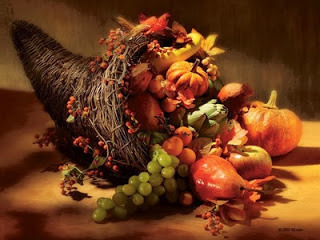
If you write to publish, you know it’s not easy. To create a book that shines can take years. For it to get noticed among the thousands of titles published each day is no small challenge, either.
Even so, I wouldn’t want to do anything else, and I’ll bet you wouldn’t either.
Here, six reasons for writers to be thankful during this season of gratitude:
Technology: I’ve been at this so long that the first two books I worked on were written when typewriters with self-correcting ribbons were as good as it got. We may grumble about glitches in our word processing programs and about the distractions of the internet, but the tools we have at our disposal today are nothing short of amazing.Options: Freedom. Control. Connecting directly with readers. The possibility of earning a living wage from our work as writers. With the digital revolution and the increasing validation of independent publishing, we enjoy more options than ever. The choices can be dizzying, and with freedom comes increased responsibility, but we’ve come a long way, baby.Community: True, we writers have our quirks. We tend to be introverts. We function in parallel worlds: the one beneath our feet, and the one we’re spinning in our heads. But all in all, we support one another. We share resources. We cooperate. And even we’re a tiny bit envious, we celebrate one another’s achievements. Masters: The books you can’t wait to read. The authors whose wisdom astounds, whose capacity for story appears boundless, whose facility with language leaves us breathless. To enjoy such inspiration is a privilege almost beyond compare.Language: So many words. So many ways to arrange them. A writer’s palette is like no other. In every line we write, the gift of language reveals itself. The supply is never depleted, and our delight in the capacities of language grows in tandem with out proficiency.Mystery: Writing is a recursive process of discovery. The process may be difficult, but it’s never dull. Where our thoughts come from, how they appear on the page, which new ways a story will turn—these mysteries keep our work fresh and exciting.
Published on November 26, 2013 08:00
November 19, 2013
How to Market Your Book: Six Components of a Successful Book Launch
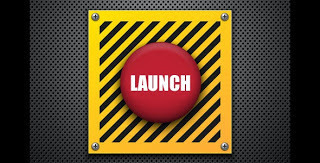
You’ve written your book. You’ve gathered responses from first readers. If you haven’t proven your chops as a developmental editor, you’ve found one to work with. You’ve revised, several times. If you’re not a good line editor, you’ve brought one to your project.
Now you’re ready to publish. You submit and submit and submit until your project is signed with a publisher, or you bypass submission in favor of independent publishing, or you finagle a hybrid arrangement, perhaps a print version through traditional channels while you handle the digital versions.
Whew. Your book is about to meet its readers.
Not so fast. To get to this point is a huge accomplishment. But you’re far from finished. You’ve only entered the next phase: promotion and marketing.
In traditional print publishing, book buzz is generated almost entirely around the launch. In order to be deemed a success, a book has to break from the gates with massive orders within the first three to four weeks. Much of how this break happens is pre-determined by the publisher’s marketing budget. Each season, a handful of books are pre-selected as blockbusters, most of them written by authors who’ve gained entrance to the winners’ circle by having been there in the past. The publisher’s resources are aimed at creating launch buzz for these books among reviewers and booksellers. Co-op funds ensure that these pre-destined hits are placed face-out at the front of bookstores. The season’s other new releases receive only minor attention from publicists, and they get only minor buzz.
One of the joys of the digital revolution in publishing is that the launch window doesn’t matter nearly as much. Given the proper attention to word of mouth and online algorithms, a good independently published digital book can gain traction slowly and steadily, with sales spikes benefiting the book at any point in its lifespan.
Still, the launch matters. That’s because key players in the industry—book sellers, reviewers, librarians, and readers—are conditioned for buzz, and buzz happens best when a product is fresh. If you’re working with a traditional publisher, that means the success metrics for your title are zeroed-in on the brief window of the launch. If you’re publishing independently, you’re still going to find the most interest in your book when it’s fresh and new.
I’ve been thinking a lot about launches because I’ve got two of them looming. First up, in February: No Returns, Book One of the Battleband Saga for middle grade readers, released in both print and digital from Running Fox Books, my own press and independent author cooperative. Next up, in September: Cold Spell, literary fiction (for grown-ups), with the print version from the University of Alaska Press and the digital version through Running Fox.
For independent projects, I prefer a launch window of at least three months. With traditional publishers, you’ll have at least several months—more likely a year or two—to gear up for your launch. You can handle a publicist to manage your launch, but be warned: it’s not cheap, and there’s no guarantee you’ll see a return in sales.
Whether you’re publishing traditionally, independently, or within a hybrid arrangement, here are six components of a successful book launch:
Groundwork: Only a Trump-like infusion of cash can substitute for good groundwork. You’ve written a book that’s a must-read. It fills a niche in the marketplace. Your approach is unique. Your prose is vibrant and fresh. Your story grips readers. If you’ve published before, your fans love your work and they’re eager for your next book. You and/or your publisher make sure that from cover to cover, your book is professionally produced. Once that’s accomplished, be sure you research whre your book fits in the marketplace, including the top writers and books most like you and yours. Make a sell sheet for your book, one that includes the promotional copy, your author bio, the book’s key words and categories, and ordering information. You’ll use it often.Network: Ideally, you’ve already identified friends and fans through personal and digital networking, and you engage with them actively, and on a regular basis, ideally through an electronic newsletter as well as social media. Before your book launches, expand these networks in a strategic but genuine ways. Genuine. I can’t stress this enough. Blatant self-promotion that’s all about you and your book will backfire. Think value-added. Enrich the lives of your friends and fans in meaningful ways, and they’ll be happy to spread the word about your upcoming book. Even your traditional publisher will expect to tap your network for reviews, blurbs, and media coverage. If you opt for a launch party, you'll invite your network.Web presence: At the minimum, you need an author website. You may also want a website for your book. Unless your book has been selected for blockbuster exposure, don’t expect your publisher to provide these sites for you. You’ll get some web exposure on the publisher’s site, but that’s not going to give you the presence and exposure you’ll get from your own web presence. I’m locked into a Homestead site from way back, but you’ll get a better value from Wordpress with third-party hosting and a GoDaddy domain. If your budget allows, you can hire out building the site, but unless you’ve got an ongoing source of cash, you should maintain your own site so the content stays fresh. For ideas on how to set up your site, look to the top authors and books in your niche. The book’s website should go up early in your launch period so you can link to it in all of your other pre-launch activities. Decide if you want a book trailer or other special features, like a media kit. Depending on how crucial the trailer is for your audience, you can make it yourself using Animoto, or you can hire a professional.Advance Reading Copies: Make sure these get out to readers who’ll follow through with blurbs and reviews, including a few movers and shakers who have a wide reach. Ideally, you want digital files in both mobi and e-pub formats, and some softcover ARCs for those who prefer them. Include a form of the sell-sheet with each ARC. If you’re traditionally published, your publisher will ask for a list of people you’d like to receive ARCs, and they’ll add to that standard review outlets like Publishers Weekly and Kirkus. They may also make the book available through NetGalley. On my independent projects, I budget for at least one big review, like Kirkus, and for NetGalley, and for a Goodreads pre-launch giveaway. I also offer digital ARCs for review by request from the book’s website.Tour: Plan a post-launch tour that includes both in-person and digital interfacing with your readers. If you only show up to sign books and pop in on the occasional blog, you’re bound for disappointment. Plan early, and plan strategically. Think of your potential readers, and consider the best venues for connecting with them: book clubs, local organizations, speaking engagements. For the blog tour component, you can hire a service like Goddess Fish to make the arrangements if you don’t have a publicist to do this for you. If you’re doing press releases, they’ll be more effective if they’re in connection with some sort of newsworthy event. With some 9000 books published daily, just the fact that yours has come out isn’t newsworthy beyond the niche groups that have a built-in interest in your work—your alma matter, the small town where you grew up or live now, your non-writing affiliations.Looking forward: It’s easy to get so caught up in promoting your book that you forget the best way to develop an audience of readers is to keep writing great books. No matter what, I devote the best portion of my writing time to actually writing—not emails, not Facebook posts, not tweets, but my next book. I refuse the notion that to be a success, a writer had to spend 80% of her time on marketing. I budget 20% of my time for promotion; the rest goes to the next book, and the next. Post-launch, I use that 20% to plan promotions around discount periods for my titles, and stay active within my network niches.
Published on November 19, 2013 08:00
November 12, 2013
Writing Women, Writing Men: What’s the difference?

Women’s fiction is a broad category. There’s “book club fiction,” with the literary crossover. There’s chick lit. There’s romance. Pretty much any novel that features female protagonists will acquire the label.
Men’s fiction? Not so much. As a label, it doesn’t exist.
My novel that comes out in September will fall in the category of women’s fiction, of the book club/literary crossover variety. On one hand, this pleases me. It’s the sort of book I like to read. Among my favorite authors are Willa Cather, Emily Bronte, Edith Wharton, Alice Munro, Jayne Anne Phillips, Kim Barnes, Annie Proulx, and Marilynne Robinson. While I read and admire many male authors, I especially aspire to write as these women do, with a brilliance of atmosphere, internalized tension, and haunting language, constructing narratives driven more by character than by plot, and with a keen reliance on place.
But as one of my writer friends pointed out, there’s a downside to the label. Based on her experience with her debut novel, she warns that if your work is labeled women’s fiction, it won’t be taken as seriously by reviewers and media outlets as a book that’s outside that category.
Another writer friend, a man, told me he’s not a big believer in gender differences among readers. “A good story should hit universal human notes, not male or female notes,” he said, adding that he was proud that his stories, published in periodicals like Gray’s Sporting Journal aimed primarily at men, had found welcome readers among his female agents and editors. He said he sometimes worried that writers both male and female took shortcuts by playing the gender card.
I agree that good stories should transcend gender, and that playing the gender card can in many instances be bad form. But—and you may call this playing the gender card if you like—from the perspective of a female writer, gender differences in readers are very much real. There's lots of good hard evidence to this effect, from third graders all the way up to the most elite in the New York publishing industry. In grade school, girls will read "boy books," but boys won't read "girl books," the distinction between boy and girl books being defined in the minds of young readers primarily by the gender of the protagonist. And I doubt that anything branded "women's fiction" in the grown-up world of books will find many men among its readers, even though there are plenty of male agents and editors among those who acquire these titles.
The larger discussion involves how few men read novels at all, and how disproportionately women writers are represented within traditional publishing. As NPR reported in “Why women read more than men,” only 20 percent of the readers of fiction are men. Book groups and literary blogs, the piece noted, are made up almost completely of women.
Psychologists posit that women have a greater “emotional range” than men, and therefore more empathy, which makes them more prone to liking fiction. The explanation for this may lie right behind our eyebrows, where our “mirror neurons” are activated by the experiences of others. It appears that women may have more of these neurons then men. Plus from an early age, girls are more verbal and don’t mind sitting for longer periods of time while engaged in a book.
The gender disparity spills over into whose work gets published and reviewed. For proof, take a quick look at “The Count” done by VIDA, an organization that probes the critical perceptions of writing by women. Given these numbers, maybe the category of Women’s Fiction has an upside. It’s at least one way to have a “room of one’s own.”
Published on November 12, 2013 08:00
Writing women, writing men: What’s the difference?

Women’s fiction is a broad category. There’s “book club fiction,” with the literary crossover. There’s chick lit. There’s romance. Pretty much any novel that features female protagonists will acquire the label.
Men’s fiction? Not so much. As a label, it doesn’t exist.
My novel that comes out in September will fall in the category of women’s fiction, of the book club/literary crossover variety. On one hand, this pleases me. It’s the sort of book I like to read. Among my favorite authors are Willa Cather, Emily Bronte, Edith Wharton, Alice Munro, Jayne Anne Phillips, Kim Barnes, Annie Proulx, and Marilynne Robinson. While I read and admire many male authors, I especially aspire to write as these women do, with a brilliance of atmosphere, internalized tension, and haunting language, constructing narratives driven more by character than by plot, and with a keen reliance on place.
But as one of my writer friends pointed out, there’s a downside to the label. Based on her experience with her debut novel, she warns that if your work is labeled women’s fiction, it won’t be taken as seriously by reviewers and media outlets as a book that’s outside that category.
Another writer friend, a man, told me he’s not a big believer in gender differences among readers. “A good story should hit universal human notes, not male or female notes,” he said, adding that he was proud that his stories, published in periodicals like Gray’s Sporting Journal aimed primarily at men, had found welcome readers among his female agents and editors. He said he sometimes worried that writers both male and female took shortcuts by playing the gender card.
I agree that good stories should transcend gender, and that playing the gender card can in many instances be bad form. But—and you may call this playing the gender card if you like—from the perspective of a female writer, gender differences in readers are very much real. There's lots of good hard evidence to this effect, from third graders all the way up to the most elite in the New York publishing industry. In grade school, girls will read "boy books," but boys won't read "girl books," the distinction between boy and girl books being defined in the minds of young readers primarily by the gender of the protagonist. And I doubt that anything branded "women's fiction" in the grown-up world of books will find many men among its readers, even though there are plenty of male agents and editors among those who acquire these titles.
The larger discussion involves how few men read novels at all, and how disproportionately women writers are represented within traditional publishing. As NPR reported in “Why women read more than men,” only 20 percent of the readers of fiction are men. Book groups and literary blogs, the piece noted, are made up almost completely of women.
Psychologists posit that women have a greater “emotional range” than men, and therefore more empathy, which makes them more prone to liking fiction. The explanation for this may lie right behind our eyebrows, where our “mirror neurons” are activated by the experiences of others. It appears that women may have more of these neurons then men. Plus from an early age, girls are more verbal and don’t mind sitting for longer periods of time while engaged in a book.
The gender disparity spills over into whose work gets published and reviewed. For proof, take a quick look at “The Count” done by VIDA, an organization that probes the critical perceptions of writing by women. Given these numbers, maybe the category of Women’s Fiction has an upside. It’s at least one way to have a “room of one’s own.”
Published on November 12, 2013 08:00
November 5, 2013
First Pages: Five Mistakes Writers Should Avoid
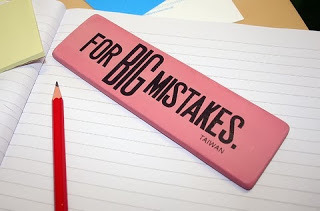
You know the importance of the first few pages. You’ve been told over and over. If your first few pages don’t captivate agents and editors, they won’t read on. If your book is published, readers won’t buy it unless they love what they read in the sample.
Secretly, you think this is unfair. You’ve got a great story. Lots of twists. Unique characters. Readers can’t tell all that from the first few pages.
Sorry. They can, and they do.
For the wrap-up of my writer’s workshop on voice, I pulled sample chapters from internet postings for my students to critique. I used the top listings that came up when I searched “sample chapter” plus the genre—thriller, in this case, because in the workshop I’ve got a few students writing in and around that genre.
The sample chapters are from authors looking to get noticed. I hope one day they will. But although they’ve taken the time (and money, if they’ve hired a proofreader) to make sure their first pages are free from obvious errors in grammar and punctuation, the samples I pulled showcase problems that will keep them from attracting a publisher or, if they’re independently published, from finding the readership that their creative efforts likely deserve.
Some of these mistakes come from trying too hard to apply writing principles like the hook that are more nuanced than you might think. Fortunately, all of these mistakes correctable.
Pull up your first few pages and see how they measure up against these five common flaws:
Clichés: From your first few pages, your readers must decide they trust you as a writer. They want proof that you’re adept and wise and original. A cliché tells them you’re sloppy and lazy and derivative. Frankly, most readers don’t have time for that. A million different directions. Pretty big stretch. Tear welled up. Tortured expression. Ghostly reflection. These are a few of the tired expressions that substitute for original language in the samples I pulled. And on that last one, the ghostly reflection, you do know, don’t you, that it’s a cliché to use a mirror (or any reflection) to show us what your character looks like? Ditto for rhetorical questions. Make it your business to identify clichés and replace them with original phrasing that earns the trust of your readers.Pacing: One misconception about the hook is that you’ll captivate readers by piling up action after action after action in the first few pages: shootouts, bloodshed, that sort of thing. Rarely does this work. There’s nothing wrong with action, but it’s not the same of a hook, and piling it all on at the beginning makes the whole thing seem clichéd.Grounding: In your eagerness to hook the reader, you frontload the narrative like it’s a newspaper article. The big questions are addressed—who, what, when, where, how, and why—but the readers aren’t there, in the narrative, because in all your explaining you’ve neglected the grounding details, those sensory images that make readers feel like they’re part of the story as it unfolds. This problem likely stems at least in part from misinterpreting comments made by early readers who say they want to know more about this or that in the story. What they really mean is that they want to have a reason to care about what’s going on. So don’t tell us Jane Doe is your narrator’s favorite client. Show us Jane Doe in such a compelling, original way that we’re drawn to her the same way your narrator is.Characters: Author Steve Almond says this best: Your readers have to know who to care about, and they have to know what that character cares about. Readers don’t care about characters simply because they materialize on the page. The characters have to touch them in some way. They’re paradoxical. Complicated. Their perspective is unique. They have voice. Once we care about your characters, we’ll care about what they care about—what’s at stake for them. That, too, should be apparent in the first few pages.Dialogue: Dialogue has to be spot on. Every time someone speaks. No exceptions. That means no dialect that makes your character more spoof than person. No blah-blah dialogue, like “Hello, I’m Jane Doe,” or “How is she?” No using dialogue as an expository tool to convey information to the reader that the characters already know.
Published on November 05, 2013 08:00
October 29, 2013
The Brave Heart of a Writer
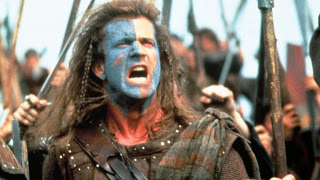
Last weekend, I delivered the keynote address at the Anchorage Young Writers Conference. Here, excerpts from my speech:
Before I became a writer, I never thought of myself as brave: I never pulled anyone from a burning building, never jumped into a freezing river to save someone from downing, never faced down a cold-blooded killer. I’d rather curl up in front of a fire and read about those brave deeds in a book.
Now I understand that writing is one of the most courageous things I’ll ever do, and that I have the brave heart of a writer. If you’re a writer, I suspect you’ve got one, too.
You might recall the film Braveheart, released in 1995. It’s the story of William Wallace, a real man who lived in 14th century Scotland. At the time of his birth, a treacherous king had invaded from England. This king kills his father and brother; only William Wallace survives. His uncle helps young William escape to Rome, where he studies in order to improve himself as a man and a warrior.Returning to Scotland, William marries in secret because the king has a policy of taking his liberties with any new bride.
When their marriage is discovered, William’s wife is murdered, but this only makes him stronger. He rallies the Scots against the evil king. Captured, he’s told to beg for mercy; instead he cries “Freedom!” When William is killed, his trusted friend Robert the Bruce surprises the English by leading the Scots to freedom, in a tribute to William Wallace.
The story of William Wallace is a story of courage. It’s also a story of success out of failure, and the truth is that in this business of writing, for each and every one of us, even the most widely read and highly acclaimed, there’s as much failure as success. That’s where your brave heart comes in.
Like William Wallace, as a writer, you’ll feel invaded: your time, your confidence, your pride. Others around you will fail. Determination, persistence—these are what carry you through. In sixteen years, I’ve been fortunate to have twelve published books. But I also have that many manuscripts—maybe more—that have never been published. I have dozens and dozens and dozens of rejections. You must decide that you’ll be a survivor.
Winston Churchill said, “Success is not final, failure is not fatal: it is the courage to continue that counts.” Or, as the wise author Lemony Snickett once wrote, “At times the world may seem an unfriendly and sinister place, but believe that there is much more good in it than bad. All you have to do is look hard enough, and what might seem to be a series of unfortunate events may in fact be the first steps of a journey.”
Remember when William went to study in Rome? Periods of retreat and study are essential. Learning makes you strong. Read voraciously; read as a writer who studies the art and craft. Read what your favorite writers say about writing, and you’ll find this common thread: the more we write, the more we realize what we still have to learn. Three years ago, I had the good fortune to study with a fine author and an expert teacher, David Vann. Though he now lives in Englandand New Zealand, David grew up in Ketchikan. When I studied with him, I’d already published several books. But I wanted to do more: to write a novel unlike any I had written before, covering territory I’d not dared before. When David showed me how language itself could be the way into a story, something clicked. The book that had been spinning inside me fell into place. The next day, I began writing it. Next fall, that book, called Cold Spell, will be published.
You’ll recall that when William married, he did so in secret. With your brave hearts, you know the value of a secret: that there are times to withhold your work until it’s ready. You’ll also know the power of a secret within a story.
When things were at their worst, William Wallace gave his all. Despite the odds, your brave heart demands your best, your all. Revise, revise, revise. I revised one of my novels four times, cover to cover.
Like William, you’ll grow strong from defeat. What you do is not for your own glory. The stakes are higher than that: Quality. Art. Your own best self on the page. “It takes courage to grow up and become who you really are,” said poet e.e. cummings. That’s what being a writer’s all about. Your moments of weakness, when you’re most vulnerable—those are your chance to show the world what you’re made of. Like most writers, my best work comes from probing those places I’d rather not go: how I was bullied in grade school, how scared I was the first time we moved, how abandoned I felt when my mother wrote me a letter and said I’d never see her again.
Remember how William Wallace was told to ask for mercy and instead he cried “freedom”? Like him, your brave heart will speak truth. What is truth? That’s a big question. So let’s just say here that for the writer, the truth is what author Steve Almond calls “the capacity to expose yourself on the page.”
Finally, like William Wallace, you will dare to have trusted friends. You will help one another against the odds. You’ll be bold enough to cheer each other on. I might not be published at all if it were not for my friend Claire Rudolf Murphy, an author who was also a teacher. In one of my stories, she recognized the potential for a full-length novel. She introduced me to her writers’ group, where I got good feedback on my project. When my book was finished, my friend Claire told me to send it to her editor, well-known in New York publishing. She didn’t worry about whose book, hers or mine, would get more attention or sell more copies. She helped me because we were friends. It’s easy to feel jealous when someone else wins an award or gets published before you do. But your brave heart has no room for competitiveness. When we honor each other, we all win.
Will you be afraid? I hope so. A wise young man one said “Without fear there cannot be courage.” As a child, this young man used to write short stories and poems. He loved the library. He loved to read. When he was fifteen, he wrote the first draft of a novel. The next year he revised it. The following year, with the help of his family, he proofread the manuscript and designed a cover. A well-known author, Carl Hiaasen, read the book and was so impressed that he recommended it to his publisher, as my friend Claire did for me. You probably know this young writer. His name: Christopher Paolini; his book: Eragon , the first in a series that to date has sold over 33 million copies.
Without fear there cannot be courage. Embrace that fear. Learn all you can, and keep learning. Persist. Give it your best. Persist. From defeat, come out stronger. Speak truth. Persist. Persist. Persist. Honor your friends, and compete with no one but yourself.
Published on October 29, 2013 08:00
October 22, 2013
Get Published!
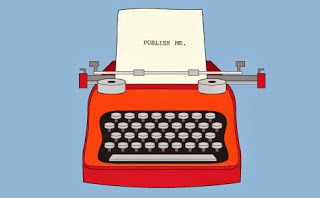
We love options.
Exhibit A: your neighborhood coffee stand, where baristas whip up your double tall half-decaf extra hot skinny vanilla and your friend’s triple vente decaf light foam half-and-half hazelnut sugar free.
But present us with too many options, and we need help.
Exhibit B: the web page with instructions on how to order your cup of Joe.
When it comes to publishing, authors these days have hundreds, if not thousands, of options. That’s a good thing, until you start mucking around trying to figure out what’s best for you and your book.
Traditional, Indie, or hybrid? Agents? Multiple submissions? Sub-rights? Digital rights? Author services? Fee-based? Twitter? Facebook? LinkedIn? Google Plus? Blogs? Blog tours? Discounting? Distribution? Covers? Blurbs? Reviews?
It’s confusing. It’s overwhelming. It’s enough to make you want to curl up with your double tall half-decaf extra hot skinny vanilla and forget about publishing altogether.
But what if help came in the form of authors who’d been there, authors with success in both traditional and independent publishing, authors who’d studied the changing marketplace? Acclaimed author Dana Stabenowproposed that she and I offer a forum like that, to share with writers what we know about publishing options and how to sort through them.
A fantastic idea, I agreed. So I’m beginning to draft a series of “Get Published” workshops that might look something like this:
Your Goals: One book, or a career as a writer? The arc of a book and a writer. The realities. An overview of what’s involved in getting a book to its readers. Your Project: Is it ready? The steps you should take to make sure, plus a one-on-one consultation with a published author about your project.Your Options: Traditional publishing. Independent publishing. Pros and Cons. How to decide. Resources. The hybrid author. Your Submissions: Entering the traditional market. Networking, including social media. Resources. Agents vs. direct submissions. Craft an effective query; one-on-one consultation with a published authorYour Indie Publishing Venture: Digital and print production. Digital and print distribution. Digital and print marketing, including social media.Your Strategies: Budgeting time and money; balancing art and business; sustaining momentum; the value in waiting; accountability; adjusting expectations; making it happen
Dear readers, what do you think? Would a series like this be helpful? Would you sign up for the whole series, or would you want to attend a la carte? What’s missing from the line-up? Is anything included that shouldn’t be?
Published on October 22, 2013 08:00
October 15, 2013
Writing Style, Writing Voice
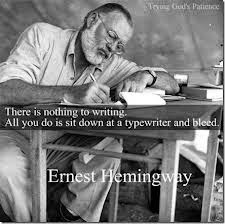
The very first workshop ever offered through 49 Writers was called “Finding Your Voice.” With funding from the Alaska State Council on the Arts, Andromeda Romano-Lax and I taught the class in a packed room off a coffee shop. We had to turn students away.
Voice is tough to teach, and we knew that going in. But it was fun, too, because it pushed us to think. “Extremely informative and thought provoking,” responded one of our students when we asked for feedback on the workshop. “Voice is an area glossed over or skipped entirely in many writing workshops, perhaps because it’s so difficult to define,” said another.
Perhaps most memorable was the student who told us that she went straight home from the workshop and wrote poem after poem after poem. That was nearly three years ago, and she’s still writing.
You still hear as much about voice as you did back then. How agents, editors, and readers are looking for distinctive voices. How voice can actually open the way into your poetry or prose. But for all the how-to posts and advice about plot and character and marketing, you won’t see much on voice. Voice feels intuitive. Squishy. Undefinable. To teach, it’s as hard—and fun—as ever. For a writer looking to break through to the next level, to get energized about writing again, to craft a piece that commands notice, I can’t think of a better angle of approach.
When 49 Writers Executive Director Linda Ketchum asked if I’d teach a voice workshop again this year, I knew straight away that as successful as that first course had been, I’d do a lot of revamping. Maybe it’s the nature of the writer to chase new material. Maybe I’ve never figured out how to do things the easy way.
In the years since that first workshop, I’ve had fun tossing around ideas about voice with other writers. (If you attended the Kachemak Bay Writers Conference this year, you might recall a certain spirited discussion on voice with my new friend Sean Hill on the Writers’ Myths panel.) Like the poet in that first workshop, I left a 2010 writers retreat with a clamoring voice in my head, a voice that had to come out. That voice engendered a novel that’s now in the last round of revisions with a publisher (Fall of 2014 release). I’ve also re-released my very first novel—and believe me, when you do that, you’ll see how much a writer’s voice can change over (ahem!) sixteen years. I’m also doing the final revisions of a novel I co-wrote with a friend. Our voices couldn’t be more different, but on the page, they’re playing nicely together.
“Sound and Fury: Find and Free Your Writer’s Voice” begins this Thursday, Oct. 17, at 6:30 pm. In four sessions of two and a half hours each, we’ll do writing exercises that will help you discover the depth and breadth of your voice. We’ll challenge some common understandings of voice and style, and how they converge with content. We’ll listen for how published work sings on the page—and for where it falls flat. We’ll consider how voice plays into decisions of narrative distance, point of view, persona, character, and dialogue. We’ll help one other revise for that distinctive voice agents and editors say they want. We’ll celebrate our unique and evolving voices, and we’ll commit to action plans to make sure our enthusiasm and progress extend beyond the last workshop session.
As of this writing, we have room for a few more students. If you’d like to join us, sign up before Thursday, Oct. 17.
Co-founder of 49 Writers, Deb Vanasse has authored twelve books. Her current projects include Cold Spell, a novel about a woman who’s obsessed with a glacier, a narrative nonfiction book called Wealth Woman: Kate Carmack and the Last Great Race for Gold, and No Returns, a middle-grade novel co-authored with Gail Giles, featuring three boys who accidentally summon the devil. She lives and works on Hiland Mountain outside of Anchorage, Alaska, and at a cabin near the Matanuska Glacier.
Published on October 15, 2013 08:00
Book Birthday!
Happy Birthday to my latest book, https://www.goodreads.com/book/show/5...! Thanks to West Margin Press for bringing it into the world and to authors C.B Bernard, Bill Streever, Gary Krist, Caroline V
Happy Birthday to my latest book, https://www.goodreads.com/book/show/5...! Thanks to West Margin Press for bringing it into the world and to authors C.B Bernard, Bill Streever, Gary Krist, Caroline Van Hemert, and Kim Heacox for their endorsements!
...more
- Deb Vanasse's profile
- 39 followers



